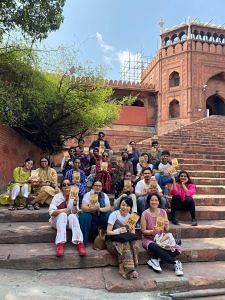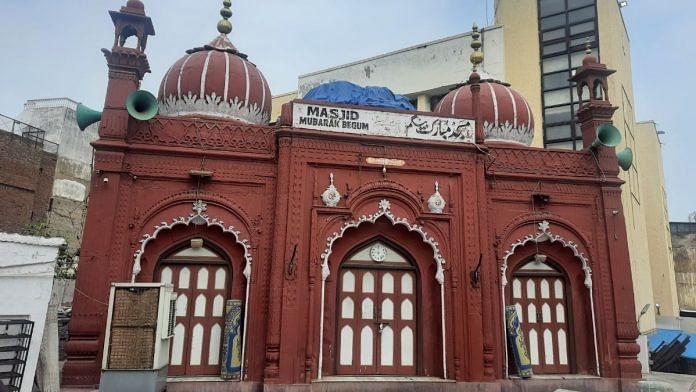New Delhi: A group of people gathered in Old Delhi on a Sunday morning – not to shop cheap in Chawri Bazaar but to learn about the lives of tawaifs or courtesans who inhabited this wholesale market street of Shahjahanabad. Famous today for its range of shops, delectable age-old cuisines, and metalware, it is hard to imagine this back lane of Jama Masjid once holding music and dance performances every evening.
Around 20 people, including history enthusiasts, tourists, and students joined the ‘Tawaifs and Kothas’ walk on 18 June, led by Anoushka Jain, the founder of women-led heritage and research organisation, Enroute Indian History. The walk is part of its wider ‘Badass Begums’ segment, which sheds light on and celebrates the forgotten histories of women who shaped Delhi.
Before commencing the unusual heritage walk, all participants received a copy of Madhur Gupta’s Courting Hindustan. The book, with a foreword by veteran Kathak dancer Birju Maharaj, talks about iconic courtesans – such as ‘Mallika-e-Ghazal’ Begum Akhtar – who became empresses, queens, prima donnas, pioneer filmmakers, ace dancers, and more.
Connoisseurs of high art and culture, tawaifs were more than just courtesans. They were courtly entertainers adept at music, dance, and poetry. Their dwellings, called kothas, were not the brothels of today. According to Jain, Mughal princesses and princes were sent to these kothas to learn elite etiquette or train in music and dancing. They can, in fact, be called ‘etiquette institutions’ of the Mughal era.

Also Read: An old Delhi heritage walk that’s not about Jama Masjid, Red Fort. It tells queer histories
Delhi’s forgotten women
We learned on the walk that these skilled traditional artistes were not a homogenous group. There were distinct ranks of tawaifs who served different roles according to their stature. While those at the lowest rung often extended sexual offers, they did it out of choice. Tawaifs at the highest rung of the Mughal entertainment world, called begums and bais, amassed huge amounts of wealth and “acquired fame that equals that of today’s finest actresses,” said Jain. Some even moved with “contingents of several hundred-armed guards,” she added. Begum Samru, an 18th-century tawaif, for one, became the ruler of Sardhana and commanded an army of 4,000 troops.
Jain says she aims to dispel the charged notions of tawaifs and kothas through her walks. Women aspiring to perform arts often voluntarily joined kothas due to the lack of autonomy in middle-class homes. Women being kidnapped and forced into prostitution started much later, depicted in films such as Umrao Jaan (1981), remarked Jain during the walk. In contrast to typical households where the birth of a girl child was frowned upon, kothas celebrated daughters who would grow up to hold superior roles and ranks. Some were even the city’s highest taxpayers and supported arts, architecture, and cultural projects.
Also Read: Chef in Delhi adding Korean twist to paratha, paneer, tikka. He’s an Instagram star
What the British did to tawaif culture
Curious onlookers watched as the wide-eyed group walked through the narrow, cacophonous lanes of what was once Shahjahanabad’s Bazaar-e-Husn (market of beauty). On this route, Jain pointed out the many erstwhile kothas and havelis that housed tawaifs. Many of these were bought by wealthy merchants in the 19th and 20th centuries, she said. “Kotha buildings are being used mostly as card and paper shops [today]. Some are rented and only a few are private properties,” she added, unsure whether present-day users knew the history of the magnificent buildings that housed them.
Kothas weren’t today’s dingy brothels, she stressed – they were rich, lively places that hosted the elite and royals of the city. Many kothas were located around temples, mosques, and dargahs, Jain added, pointing out that tawaifs even funded religious institutions and lived near them – such as the north gate of Jama Masjid.
But the arrival of the British would soon change the complex yet colourful social fabric of Mughal India. Failing to understand the tawaif culture, Jain said “they reduced them all to dancing women, labelling them as ‘nautch girls’.” She added that many British elite of the time took them as mistresses and wives or simply used them as prostitutes.
“Everything changed after the 1857 revolt,” though, which saw the removal of the feudal class of Shahjahanabad. As their patron class disappeared overnight, tawaifs would soon see a drastic change in their status and wealth. British ‘anti-nautch’ campaigns targeted tawaifs and forced them to relocate.
Tracing the status of women throughout the years, Jain led the group to the Indraprastha Hindu Girls’ Senior Secondary School as one of the last stops of the walk. Participants were surprised to learn that it was the parent institution of Delhi University’s renowned Indraprastha College for Women. Jain said that she included this institution in her walk to reflect upon the journey women have undergone – from respected tawaifs to British nautch girls to educated women following the rise of India’s feminist movement.
From here, the walk progressed to its last stage – the Jama Masjid. Sitting on the steps of the north gate’s stairway, the group discussed Madhur Gupta’s book. Jain reminisced how these stairs represented the “soul of Delhi”, serving as a hub of social, cultural, and economic activity for centuries.
(Edited by Zoya Bhatti)



